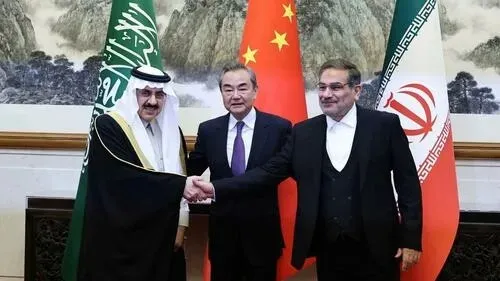by John Rubino, John Rubino:

Since the 1970s it’s been virtually impossible for a country to function without access to US dollars. And Washington maintained this highly-favorable status quo by putting various kinds of pressure — from sanctions to election theft to outright invasion — on anyone who stepped out of line.
This weaponization of the world’s reserve currency has, not surprisingly, created resentment in a lot of foreign capitals. And after a long gestation period, that resentment is now erupting into a rebellion against dollar hegemony. Among the big recent events:
TRUTH LIVES on at https://sgtreport.tv/
The BRICS coalition has become the hottest ticket in geopolitics. Brazil, Russia, India, China, and South Africa (the BRICS) have been toying with the idea of forming a political/monetary counterweight to U.S. dominance since 2001. But beyond some aggressive gold buying by Russia and China, there was more talk than action.
Then the floodgates opened. Whether due to the pandemic’s supply chain disruptions, heavy-handed sanctions imposed by US-led NATO during the Russia-Ukraine war, or just the fact that de-dollarization was an idea whose time had finally come, the BRICS alliance has suddenly become the hottest ticket in town. In just the past year, Argentina, Indonesia, Saudi Arabia, Iran, Mexico, Turkey, the United Arab Emirates (UAE), and Egypt have either applied to join or expressed an interest in doing so. And new bilateral trade deals that bypass the dollar are being discussed all over the place.
Combine the land mass, population, and natural resources of the BRICS countries with those of the potential new members and the result is more or less half the world. And now things are getting real:
China brokers a peace deal between Saudia Arabie and Iran, two bitter historical enemies who want to join the BRICS alliance but can’t if they’re in an undeclared war. Should they stop competing and start cooperating they could dominate the Middle East and raise China’s clout in the region, at the petrodollar’s expense. An example of the press coverage:
Eurasia’s geo-economic integration took a great leap forward as a result of the Iranian–Saudi rapprochement, which unlocks the Gulf Cooperation Council’s (GCC) trade potential with Russia and China. Its wealthy members can now tap into two series of Iranian-transiting megaprojects in one fell swoop through this deal, with the North-South Transport Corridor (NSTC) connecting them to Russia while the China-Central Asia-West Asia Economic Corridor (CCAWAEC) will do the same vis-à-vis China…
…Only two weeks after Saudi Arabia announced an effort to establish diplomatic ties to Iran in a deal mediated by China, more news surfaced that Saudi Arabia was also planning to reopen its embassy in Syria for the first time in over a decade. Rumors are swirling that Iran, Saudi Arabia and Syria are on the verge of geopolitical and economic agreements that sidestep the US.

Russia and India agree to trade oil for rupees. Russia is now India’s largest oil supplier, with 35% of that massive, growing country’s imports. The U.S. is not happy about this — but India doesn’t seem to care. From a recent article:
Even the US itself seems to have finally accepted that it can’t reverse this trend, which is evidenced by former Indian Ambassador to Russia Kanwal Sibal recently telling TASS that “Lately, the discourse from Washington has changed and India is no longer being asked to stop buying oil from Russia. In a recent visit to India, the US Treasury Secretary actually said that India can buy discounted oil from Russia as much as it wants so long as western tankers and insurance companies are not used.”
African leaders travel to Moscow. Representatives of 40 African nations traveled to Rissia for the Second International Parliamentary Conference “Russia – Africa in a Multipolar World.” According to the press release, the attendees:
… discussed the potential for collaboration across a range of sectors, their contribution to the African continent’s economy and security, and their work in the realms of science and education, politics, and techno-military area.
During the conference, the African continent was invited to work together to form a new multipolar world order. This is especially important given the significant human resources of Africa, which is home to more than 1.5 billion people and has enormous mineral reserves in its soil.
Brazil and Argentina announce a common currency. In February, the two dominant Latin American economies announced plans for a common currency called the “sur” for use in bilateral trade. South America is a big, resource-rich place with numerous grudges against its intrusive northern neighbor. So a de-dollarization movement there, while not as immediately consequential as what’s happening in the Middle East or Asia, is both plausible and potentially serious for the dollar.
Lower Dollar, Higher Gold
Even in an emerging multi-polar world, there’s no obvious replacement for the deep, liquid US capital markets. So the dollar won’t disappear from global trade. However:
- If the BRICS have the commodities and the US and its allies are left with finance, pricing power for crucial things like oil and gold will shift to Russia, China, and the Middle East.
- Falling demand for dollar-denominated bonds as reserve assets will send trillions of dollars now outside the US back home, raising domestic prices (which is to say lowering the dollar’s purchasing power and exchange rate).
- The loss of its weaponized reserve currency will lessen the US’ ability to impose its will on the rest of the world (witness China as Middle-East peacemaker and India buying Russian oil with rupees).
To sum up, tomorrow’s world is multi-polar, and for the US and its allies, inflationary. That means a commodities bull market — at least in dollar terms — and extreme financial instability as the US Empire is forced to live within its means. It won’t be pretty but for gold bugs and commodity bulls, it might be extremely profitable.
I’ll leave you with this:
Read More @ rubino.substack.com



